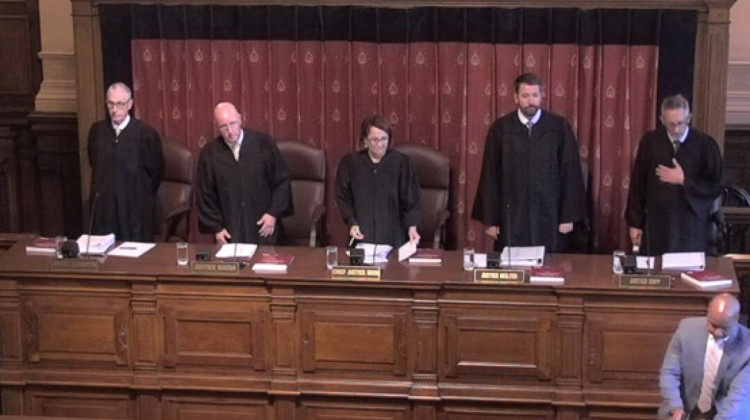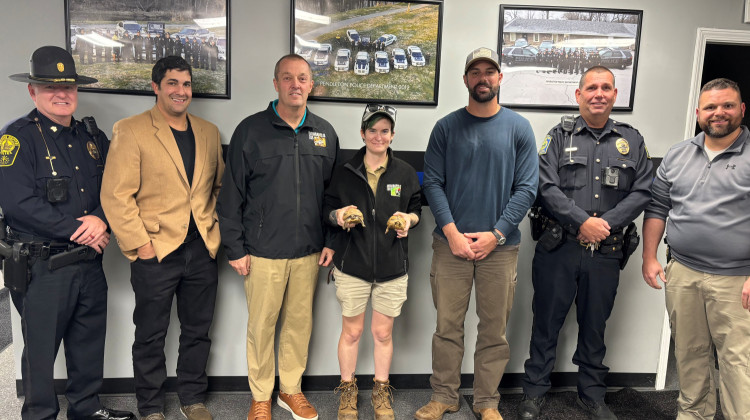Almost one year ago, a mother made a 911 call in the middle of the night. She needed mental health help for a 39-year-old Black man, an accomplished Indianapolis musician, and a beloved son.
Gladys Whitfield and her husband, Herman Whitfield II, wanted an ambulance. They did not know their child – Herman Whitfield III – would be declared dead about an hour later, after six Indianapolis Metropolitan Police Department officers were dispatched to their home and tased him.
“He actually was born at the same hospital where they took his body when he died,” Gladys Whitfield said.
Advocates said Whitfield III’s death was preventable. His family, community members and experts agree that changes are needed to stop more lives from being lost.
Last June, when IMPD released an edited video version of police responding to the Whitfield home, Chief Randall Taylor said he thought Herman Whitfield III’s cause of death was unclear.
“Nobody knows why this man is dead,” Taylor said.
A few weeks later, the Marion County Coroner's Office ruled the death a homicide. The cause of death was “cardiopulmonary arrest in the setting of law enforcement subdual, prone restraint, and conducted electrical weapon use.”
The criminal case is currently in the hands of the Marion County Prosecutor’s Office, while it determines if criminal charges against the officers are appropriate. A separate internal investigation by IMPD is still underway.
The Whitfields have filed a federal wrongful death lawsuit against the city. As part of the lawsuit, IMPD was ordered to release the entire, unedited body camera footage. It shows the final minutes of Herman Whitfield III's life, and the series of failures that led to his death.
The body camera footage can be accessed here. Warning: these videos contain content that some may find disturbing.
IMPD declined to respond to a list of questions sent by WFYI about Whitfield’s case, citing the
ongoing criminal investigation and federal lawsuit.
Police response
IMPD Officer Dominique Clark was first on the scene that night with her partner, Officer Adam Ahmad. They responded to the Whitfield family’s northeast side home in the early hours of the morning on April 25, 2022.
Herman Whitfield III was having a mental health crisis. While he had never received a mental health diagnosis – to his parents’ knowledge – he had experienced recent episodes where he’d become disoriented. His mother said they’d been able to calm him down.

As Clark and Ahmad approached the house, Herman Whitfield II came to the door.
“You guys should have called an ambulance,” he said.
His son stood in the back of the home, naked, and moved back and forth from his bedroom into a hallway.
At first, the officers tried to communicate with Whitfield III. Clark told him that she only wanted to talk. He said “OK” multiple times, but did not respond to requests to come out to them or put on clothing.
Gladys Whitfield expressed worry as more police were called to the scene.
“They’re not going to kill him, are they?” she asked the officers.
The next two officers to arrive on the scene were Nicholas Mathew and Jordan Bull. It’s common for multiple police units to arrive on the scene of a response, but the Whitfields said they didn’t understand why more were needed.
“It was crowded. It was overwhelming. It was intimidating. It was scary. Our son is having problems. All these police are in here,” Gladys Whitfield said.
The back of the home was dark. Officers used their flashlights, and often shone them directly in Whitfield III’s face.
Clark asked Mr. and Mrs. Whitfield to help, but they were not experts on the best tactics to use.
The last two officers to arrive were Steven Sanchez and Matthew Virt.
“I didn’t take a good look at this run,” Virt said.
When Sanchez and Virt arrived, the Whitfields and the four other officers were still trying to talk to Whitfield III and convince him to get dressed. Instead, he rushed out of his room, knocking over items in the unlit kitchen.
Whitfield III appeared to be trying to get away from the officers, and headed towards the dining room.
“Keep that taser up,” Virt told Sanchez.
Sanchez, who was standing in the front room, fired his taser twice.
Herman Whitfield II said at the time, they didn’t realize what had happened.
“I had no idea that they were gonna do that…No, they didn't say anything. Yeah, like we didn't matter,” said Herman Whitfield II.
Herman Whitfield III cried out “fire” and “I’m dying” after the taser voltage struck him. He fell into the dining room table, and vases of flowers toppled as he pulled the tablecloth down with him. It was wrapped around his head and torso.
“Stay on his head,” Ahmad instructed.
Sanchez held his head down.
“I can’t breathe,” Whitfield III said, at least three times. Off-camera, his father is heard urging him to calm down.
The officers struggled to handcuff him, and he ended up wearing two pairs because of his size. As the seconds passed, Whitfield III stopped talking and moving.
“We didn’t exist,” said his father. “It's like we wasn’t even there. Even though we were at home.”
Mathew, who had been on the force for less than a year, was the only officer to ask if Whitfield III should be moved.
“No. I don’t want him to get up again," Ahmad answered.
“Well, he got his wish,” Gladys Whitfield said. “He never got up again.”
Herman Whitfield III’s legacy
Herman Whitfield III was a piano prodigy, a well-known figure in the Indianapolis music scene. He composed music. He had multiple degrees and the respect of accomplished masters.
“He was a good baby. He liked music from a very young age. And he liked church too,” Gladys Whitfield said.
He was interested in architecture. His parents said he collected drawings of churches and cathedrals.
“You know, he'd even get an encyclopedia and read it from cover to cover. One at a time,” Herman Whitfield II said. “Just sit there reading encyclopedias.”
The pandemic may have been hard for Whitfield III. He was living with his parents. Opportunities for him to play live music and interact with other musicians were few.
“I think he didn't like it,” Gladys Whitfield said. “And I think it kind of cut back on his opportunities to perform and to work. “
Whitfield III’s musical legacy in Indianapolis – and his talent – live on. One of his compositions aired on a special episode of WFYI’s Cultural Manifesto the week after his death.
“Today, I want to pay tribute to the remarkable musical brilliance of Herman Whitfield III,” said show host Kyle Long, as he introduced Whitfield III’s “Sonata for Violin and Piano No. 2.”

Gladys Whitfield said she took her son to a piano teacher at the age of four. The teacher thought he was still too young to play, but invited them to come over for an evaluation.
“So I did,” she said. “And then she said, ‘Oh, no, he's ready.’”
The prone position
The IMPD officers held Herman Whitfield III down in the prone position, his face pressed into the floor, for more than five minutes. When paramedics entered the home, they checked for Whitfield III’s pulse – then directed the officers to move him onto his side.
When someone is placed prone, they are lying face down on the ground. When used in a law enforcement setting, the person is often handcuffed. The U.S. Department of Justice warned law enforcement agencies across the country in a 1995 memo about the dangers of the prone position leading to positional asphyxia.
According to IMPD’s General Orders, officers are told to look out for certain behaviors that pose a greater threat of positional asphyxia if the person is placed prone. These include exhibiting “bizarre” behavior outside the norm, shouting and screaming – especially at inanimate objects – hallucinations, paranoia, and profuse sweating.
Other conditions, such as being overweight, make the prone position more likely to result in death. The Marion County Coroner listed “morbid obesity” as a contributing condition to Herman Whitfield III’s death.
“An arrestee/detainee placed on their chest or back may have difficulty breathing, leading to serious injury or death,” IMPD’s General Orders read.
The General Orders also read that people should be placed in the recovery position “as soon as possible.”
Seth Stoughton, a law professor at the University of South Carolina and national expert in police use of force, said while the prone position can be an effective way to handcuff someone quickly, it can be extremely dangerous.
It’s essential that officers move someone out of the prone position quickly, even if they are still resisting to some extent, he said.
Stoughton also said while there are many police agencies across the country that all have different policies and procedures, there is agreement that the prone restraint is dangerous.
“I don't think there's any reasonable dispute at this point in policing about the risks of positional asphyxia and the protocols used to avoid prone restraint,” he said.
A push to improve the response to mental health crises
People with mental health disorders are more likely to come in contact with police than receive medical care. According to the Washington Post, more than 20 percent of all people killed by police since 2015 were experiencing a mental health crisis.
Bianca Harris is a therapist and owner of the Phoenix Nicholas Center in Indianapolis, which provides therapy and mental health training services. She also works as an organizer for the Black Church Coalition, part of the social advocacy group Faith in Indiana. Harris said in an ideal world, police would not have responded to the Whitfield home at all. Instead, a trained support team would have come to provide resources to both Herman and his parents.
“A police presence does not deescalate the situation; it creates more anxiety,” Harris said.
She said someone struggling with a mental health crisis might also perceive that the arrival of law enforcement means they’ve committed a crime.
“And there are situations where we can jump into fight or flight, and that causes more tension,” Harris said.
The failure of police responses to mental health calls has led to a community call for reform in Indianapolis. A task force studied the issue in 2016.
MCAT, or the Mobile Crisis Assistance Team, launched in 2017. The team includes a clinician from Eskenazi Health, and an IMPD officer. Originally, Indianapolis EMS was also part of the response. It pulled out of the partnership in 2018, citing a lack of results.
Indianapolis City-County Council member Ethan Evans worked as a community activist as the program launched. He said MCAT had gaps from the start.
“Acknowledging that we need to have something 24/7 in these multiple areas, as well as something that I, along with many community members, said – call for someone on the 911 call center to be a mental health clinician, or at least someone trained in that regard,” Evans said.
Advocates like Faith in Indiana organizer Josh Riddick and Carlos Perkins, senior pastor at the Bethel Cathedral African Methodist Episcopal Church, said the MCAT system isn’t enough.
MCAT operates on weekdays from 8 a.m. to 6 p.m. Riddick and Perkins emphasized that mental health crises can happen at any time of the day. In Whitfield III’s case, it was about 3:30 a.m.
Additionally, MCAT has limited staff -- and responds to incidents in a city with the busiest 911 call center in the state.
Riddick, Perkins and other community members also said they believe police should not be responding to mental health crises.
“There's a lot of different ways we can build response mechanisms that are not law enforcement,” Riddick said. “That is a choice at the city level to do that every time.”
Perkins emphasized that Faith in Indiana is not against law enforcement as a whole, but that resources can be better distributed.
“What we're saying is that individuals that are experiencing a mental health crisis should be afforded the resource that's going to give them the help that they need, and for them not to end up dead or incarcerated,” he said.
But creating a system that’s available more often – and does not use police – requires funding, and a commitment from the city.
Is reform possible?
A new, all clinician-led pilot program has been approved by the city, with $2 million in funding allocated.
The push comes as other cities have successfully reduced fatal police encounters with people in mental health crises. Indianapolis leaders have looked to cities like Denver, which has teams that do not include police officers.
The Denver Support Team Assisted Response – or STAR – pairs a mental health clinician with a paramedic or EMT. They respond to a variety of calls, helping people with behavioral health crises, homelessness and poverty.
Carleigh Sailon, the operations manager of the STAR program, said another program included a police officer in the response team, but the city found that officers were not needed for most of the calls as there was no public safety or criminal threat.
“We started thinking about what additional options we could create, to make sure that we were keeping our officers and co-responder teams focused on what their job responsibilities were really intended to be,” she said.
While the commitment to a pilot program in Indianapolis is a start, Riddick emphasized that gaps in mental health responses are a statewide problem. Many have rallied behind a bill moving through the current legislative session, Senate Bill 1, which could expand access to better care across Indiana.
Harris says its fully funded passage is a priority.
“The state of Indiana should have crisis response teams to meet the actual needs of its residents,” Harris said.
At a recent Black Church Coalition event held at the Statehouse in support of SB1, Perkins underlined that the Whitfield family was unable to access the kind of mental health resources the legislation could make possible.
“We believe that no family around the state of Indiana should experience that, ever again,” Perkins said. “Should experience the trauma of losing your child because you’re calling for help.”

Will police be held responsible?
The criminal investigation into Whitfield III’s death is ongoing. The officers involved are still working for the department, but are on administrative duties instead of patrols.
Gladys Whitfield said those officers didn’t encounter her son in the outside world.
“He was in his own house,” she said. “To think that they killed him in his own house every day.”
Community calls for justice came quickly after Whitfield III’s death – including from his friend Dea Lott, who founded the group Justice 4 Herman. Like family members, she has always called him Trey.
“This is not the mental health system – that didn't kill Herman, it didn't kill Trey. The police officers killed Trey, and it, you know, it was unjustified,” Lott said.
The movement to transform police transparency and accountability often hinges on body camera footage. In 2020, following a summer of protests that centered on police misuse of force, the Indianapolis Metropolitan Police Department committed to body-worn cameras for all officers. The city invested $9 million to expand the technology, previously used in pilot programs.
Lott said everyone should bear witness to police action.
“These same people are in the community, they're in the community, and they may be still doing this to other people, and in other ways – and that may never come to the forefront. That may never get that story,” Lott said. “And so that's everybody's problem.”
Once the criminal investigation is complete, the civilian majority Use of Force Review Board will examine it to determine if the officers followed proper policy. Ultimately, the decision to fire the officers rests with the chief.
Reforming the law enforcement response to mental health calls is more complex. The new clinician-led team may help, but it won’t eliminate the possibility that police could be called to a crisis scene – or the possibility that police won’t follow proper training procedures.
“I understand that some people don't, or believe that not everybody is human, or not every human has the same rights, or that their life is sacred,” Gladys Whitfield said. “But what about your policies? That's what they're there for.”
Lott said she believes the effort will have to include better, more precise training from IMPD and accountability for officers who fail to follow protocol.
“Make sure that the police who are working for you are doing their jobs right, and understand that their role is to protect and serve the community – all of the community – and when there is a violation of that,” Lott said.
Riddick said a collective outrage from everyone in all communities is also needed.
“I long for more in our community to say this is unacceptable, and to feel that same rage, and that same sadness and that same grief,” he said. “I long for a community to know that there is a mother's grief and tears who are being sowed in the ground and hoping that justice springs from it. And that we have a responsibility to help that come to pass.”
Contact WFYI criminal justice reporter Katrina Pross at kpross@wfyi.org. Follow on Twitter: @katrina_pross.
Pross is a Corps Member of Report for America, an initiative of The GroundTruth Project.
Contact WFYI city government and policy reporter Jill Sheridan at jsheridan@wfyi.org. Follow on Twitter: @JillASheridan.
 DONATE
DONATE







 Support WFYI. We can't do it without you.
Support WFYI. We can't do it without you.